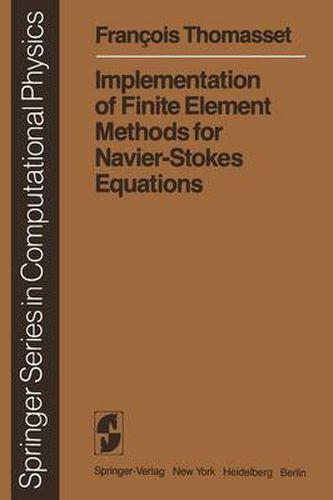Implementation of Finite Element Methods for Navier-Stokes Equations
F. Thomasset

Implementation of Finite Element Methods for Navier-Stokes Equations
F. Thomasset
This title is printed to order. This book may have been self-published. If so, we cannot guarantee the quality of the content. In the main most books will have gone through the editing process however some may not. We therefore suggest that you be aware of this before ordering this book. If in doubt check either the author or publisher’s details as we are unable to accept any returns unless they are faulty. Please contact us if you have any questions.
In structure mechanics analysis, finite element methods are now well estab lished and well documented techniques; their advantage lies in a higher flexibility, in particular for: (i) The representation of arbitrary complicated boundaries; (ii) Systematic rules for the developments of stable numerical schemes ap proximating mathematically wellposed problems, with various types of boundary conditions. On the other hand, compared to finite difference methods, this flexibility is paid by: an increased programming complexity; additional storage require ment. The application of finite element methods to fluid mechanics has been lagging behind and is relatively recent for several types of reasons: (i) Historical reasons: the early methods were invented by engineers for the analysis of torsion, flexion deformation of bearns, plates, shells, etc … (see the historics in Strang and Fix (1972) or Zienckiewicz (1977 . (ii) Technical reasons: fluid flow problems present specific difficulties: strong gradients,l of the velocity or temperature for instance, may occur which a finite mesh is unable to properly represent; a remedy lies in the various upwind finite element schemes which recently turned up, and which are reviewed in chapter 2 (yet their effect is just as controversial as in finite differences). Next, waves can propagate (e.g. in ocean dynamics with shallowwaters equations) which will be falsely distorted by a finite non regular mesh, as Kreiss (1979) pointed out. We are concerned in this course with the approximation of incompressible, viscous, Newtonian fluids, i.e. governed by N avier Stokes equations.
This item is not currently in-stock. It can be ordered online and is expected to ship in 7-14 days
Our stock data is updated periodically, and availability may change throughout the day for in-demand items. Please call the relevant shop for the most current stock information. Prices are subject to change without notice.
Sign in or become a Readings Member to add this title to a wishlist.


